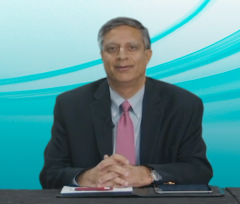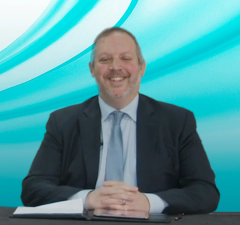
Case Presentation: An 82-Year-Old Woman with Transplant-Ineligible Multiple Myeloma
Dr Nisha Joseph presents the case of a woman with transplant-ineligible multiple myeloma and discusses considerations when choosing frontline treatment regimens.
Sagar Lonial, MD: We’re going to move on to transplant-ineligible patients. Dr Joseph is going to start with a case and then we’ll have some discussion around that case.
Nisha Joseph, MD: Let’s start with this case. This is an 82-year-old woman. She was diagnosed with a solitary plasmacytoma initially in the fall of 2018. She received definitive radiotherapy at that time. The following March she was admitted from clinic with hypercalcemia up to 12.3 mg/dL and anemia with a hemoglobin of 8.8 g/dL. Repeat immunologic studies were sent showing a paraprotein of 0.2 g of an IgA [immunoglobulin A] kappa and elevated free kappa light chains levels of 600 mg/L, with a ratio of 215. Repeat bone marrow biopsy was done which showed 40% to 50% clonal plasma cells, and genetics were significant for translocation t(11;14) as tested on a FISH [fluorescence in situ hybridization] panel. Skeletal survey was also done, which showed diffuse lytic deposits throughout the axial and appendicular skeleton, with compression deformities at T6 [sixth thoracic vertebra], T7, L4 [fourth lumbar vertebrae], and L5.
While in the hospital, she underwent palliative kyphoplasty to help with her pain, and then was discharged to follow up with us in clinic. She was then initiated on a combination regimen of daratumumab, lenalidomide, and dexamethasone [DRd], which she started in April of 2019. She had a good response and good tolerance, with normalization of her free light chains by cycle 6. She was continued on daratumumab with lenalidomide and dexamethasone until April of 2021, where she had a rising free light chain that met criteria for disease progression. She was switched to bortezomib, pomalidomide, and dexamethasone [PVd] per the OPTIMISMM trial, which she continues on to this day.
Sagar Lonial, MD: One of the big questions that comes up is how do we differentiate between what we use for the fit transplant-eligible patients and the older, frail transplant-ineligible patients? We can certainly talk a little about it. Do we use age as the cutoff? Do we use functional status? Do we use frailty? That’ll come up a little here as well.
When we think about regimens that we use in this clinical situation, historically, a standard has been modified RVd [lenalidomide, bortezomib, dexamethasone]. Whether that’s weekly dosing or lowering all the doses of all the drugs, it’s pretty clear that when you’re over eighty, 40 mg of dexamethasone is a bit of a stretch. Certainly, that dose adjustment can be important, but there are 3 or 4 different versions of RVd lite or modified RVd. We can talk through those as well. Daratumumab-lenalidomide-dexamethasone has been another standard. Then there are some patients in whom we just think about lenalidomide-dexamethasone, which supplanted all of the melphalan-based approaches over the historic last 2 decades of treatment.
Dr Joseph, how do you choose a treatment? With things like doublets and triplets, what gauges, like performance status, do you use to make some of those decisions?
Nisha Joseph, MD: I think about 3 different things: performance status and frailty, comorbidities generally in these older patients, and then disease status of high risk versus standard risk. Even though we’re talking about transplant-eligible patients, I generally reserve doublets for the super-frail population, maybe patients in their 90s who have poor performance status. As you referenced the FIRST trial with lenalidomide-dexamethasone, that might be a good option for them, with dose-reduced lenalidomide and certainly dose-reduced dexamethasone. But for other frail patients who aren’t quite so frail, they tolerate triplets quite well, particularly daratumumab-lenalidomide-dexamethasone per the MAIA study.
Outside of other comorbidities that would prevent that for standard-risk patients, I usually opt for daratumumab-lenalidomide-dexamethasone. For high-risk patients, recognizing the utility of proteasome inhibition in high-risk disease, I often go for RVd, which showed to have a benefit in the SWOG study. As you referenced, I often do the lite dosing, even though we can talk about schedule. It was published at 35-day cycles. We tend to do 28-day cycles for ease with weekly Velcade [carfilzomib] and dexamethasone and dose-reduced Revlimid [lenalidomide]. Those are usually the options that I have for those folks.
Sagar Lonial, MD: Before I go to Dr Nooka to give us the rundown of the updates on MAIA, I want to turn to Dr Kaufman briefly. Let’s say this patient were aged 77 or 78 instead of 82. What are you looking for to make that decision about whether to transplant? Because there’s this perception in the community that if they’re over 70, don’t even refer for a transplant, and we’ve got published data on benefits for patients over 70 with high-dose therapy. How do you navigate that decision? Then we’ll turn to Dr Nooka.
Jonathan Kaufman, MD: We think about performance status, comorbidities, and overall fitness. When I think about performance status in the setting of newly diagnosed myeloma, I’m asking the question, what was your performance status 6 months before you were diagnosed? If a patient has a poor performance status because they have newly diagnosed myeloma, they’re in a lot of pain, and they’re in their 70s, I’m in large part going to give them the benefit of the doubt that once we treat their myeloma, their performance status is going to get back to their pre-myeloma performance status.
If somebody was frail and then diagnosed with myeloma, treating their myeloma isn’t going to undo that frailty. Whereas if somebody was living their normal life in their mid-70s, still doing all their normal activities, and was sick from myeloma, I’m going to consider that patient a transplant-eligible patient and consider some quadruple therapy, maybe with appropriate dose modifications. The other thing is, if we know a patient isn’t going to be a transplant candidate based on comorbidities, significant heart disease, significant lung disease, or significant liver disease, then we know from the start that they aren’t going to be a transplant candidate ever, and we think about our non–transplant-eligible regimens.
Transcript edited for clarity.
Newsletter
Stay up to date on recent advances in the multidisciplinary approach to cancer.























































































